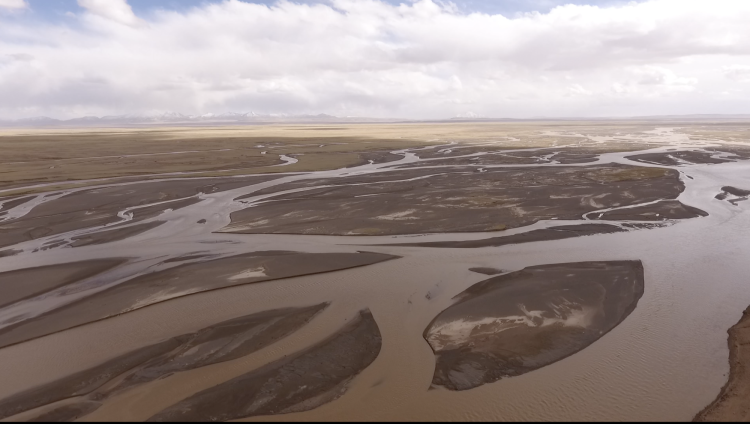Runoff, sediment flux in High Mountain Asia could limit food, energy for millions
Average temperatures in high altitude areas have risen twice as fast as the global average, causing more river runoff and sediment flux, and the trend could get worse, scientists find
Rivers flowing from the Tibetan Plateau and the surrounding high Asian mountains which support one-third of the world’s population have experienced rapid increases in annual water and sediment runoff since the 1990s, and the volume of sediment washed downstream could more than double by 2050 under the worst-case scenario, a team of scientists has found.

Above: Irina Overeem. At the top of the page: The Gangjiaquba Glacier on the Tibetan Plateau with visible suspended sediment. Photo by: Yinjun Zhou.
The cause is “amplified warming”: Since 1950, the High Mountain Asia area, or the region of Asia containing five mountain ranges including the Himalaya and Hindu Kush around the Tibetan Plateau, has warmed by about 2 degrees Celsius, twice the amount of warming worldwide. That warming is precipitating more glacier melt, permafrost thaw while annual rainfall is also increasing, the researchers note.
“These findings have far-reaching implications for the region’s hydropower, food and environmental security,” the researchers observe. The findings also highlight the under-appreciated importance of sediment fluxes and have implications for potential changes in the global carbon cycle, they add.
The research, published today in the journal Science, is led by the National University of Singapore and includes three researchers from the University of Colorado Boulder, including Irina Overeem, Jaia Syvitski and Albert Kettner, all researchers in the Institute of Arctic and Alpine Research. Overeem is also a CU Boulder associate professor of geological sciences, and Syvitski is professor emeritus of geological sciences.
The scientists analyzed observational data of runoff and sediment fluxes from 28 headwater basins over the past six decades.
Sediment flux is the mass of sediment that passes through a specific point in a river basin over a given time period, “like truckloads of sand being transported, in this case by water,” Overeem said. Although river runoff, the amount of water entering a river system, and sediment flux are both increasing, they are rising at different rates.
In the river basins the scientists studied, runoff increased by about 5% per decade, while sediment flux increased about 12% per decade.
Overeem explained the variability is affected in two ways: “With glacial melt and permafrost thaw there are new sources of sediment, that previously had been frozen in place in the landscape now can slump into the river. In addition, if more rainfall triggers bigger floods, you suddenly have exceeded a threshold and you can pick up so much more sediment” compared to average conditions. “If you increase the source and the proportion of a couple of these extreme events, you'll get disproportionally much more sediment. So that is maybe what's going on in this system.”

Braided River at the Yangtze headwaters. Photo by Dongfeng Li
River-borne sediment can benefit highly populated areas like Bangladesh, where sediment helps maintain the coastal zone. But in other areas such as Tibet or Nepal, which have hydro-electric power plants, rising levels of sediment can wear out the dams’ turbines and fill reservoirs with sand and silt.
By harming existing or planned hydropower projects and reducing irrigation capacity, rising sediment fluxes can thus “threaten the region’s food and energy security,” the authors write. Additionally, the rising levels of sediment, which can carry nutrients, pollutants and organic carbon, can have implications for water quality and flooding, potentially affecting millions of people.
Research on the High Mountain Asia watershed was facilitated by the area’s unusually good, long-term records of streamflow and sediment flux, Overeem said, adding that datasets of similar quality do not exist for Greenland or the whole Arctic.
In the Arctic, scientists have also recorded increases in water discharge from melting ice and increasing rainfall but have few measurements of sediment flux.
“What is happening on the Tibetan plateau may be happening in the Arctic as well, but we just don't have enough long records there and observational support to really know that yet,” Overeem said.
The research was led by Dongfeng Li and Xi Xi Lu of the National University of Singapore.

